Explore The Fringes Of RC Flight
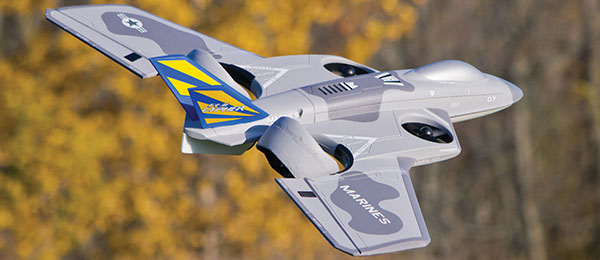
Written by Terry Dunn Flex Innovations FV-31 Cypher VTOL EDF Super PNP As seen in the February 2020 issue of Model Aviation.
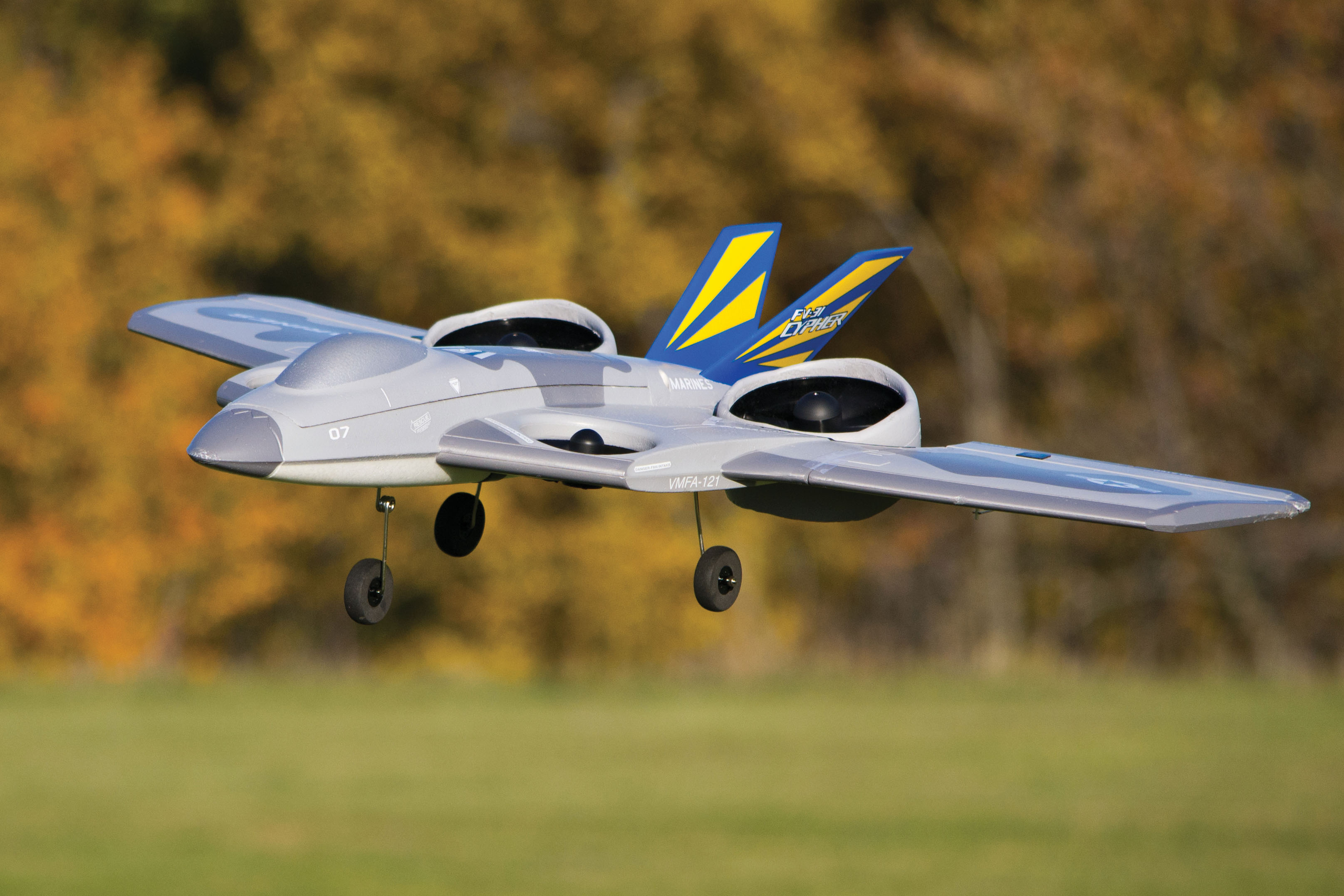
I’VE ALWAYS BEEN FASCINATED BY unique aircraft designs. Whether it’s an airplane that merely looks strange or one that accomplishes flight in an unconventional manner, my interest is piqued. The new FV-31 Cypher from Flex Innovations hits on both points.
With a jetlike flying-wing planform, this model has a distinctive profile. It’s not likely to be mistaken for anything else at the flying field.
The Cypher is powered by four electric ducted fans (EDFs). Two of those fans can be tilted in flight to push the model through maneuvers that will have onlookers watching slack-jawed in disbelief. This is my kind of aircraft!
No Runway? No Problem
The primary distinction of the FV-31 is that it is capable of Vertical Takeoff and Landing (VTOL). The model can ascend from the ground vertically and hover in place, much like a helicopter or multirotor. With the flip of a switch, the Cypher will transition into conventional forward flight. You can also convert back to hovering flight for landings. I’ll cover more details of this model’s VTOL chops in a bit.
The FV-31 has a factory-built, molded-foam airframe that is painted in one of two color schemes. Mine is decked out in two-tone gray camouflage with U.S. Marine markings. The red, white, and blue U.S. Air Force option is slightly flashier.
Flex Innovations offers the FV-31 as a Super Plug-N-Play (PNP) package that provides everything you need except a three-cell LiPo battery (2,200 to 5,200 mAh, 40-plus C) and a receiver. This model requires an SBus type of receiver with at least six channels. The manual lists numerous applicable receivers from several radio manufacturers. I used a tiny Spektrum SMP4649T receiver.
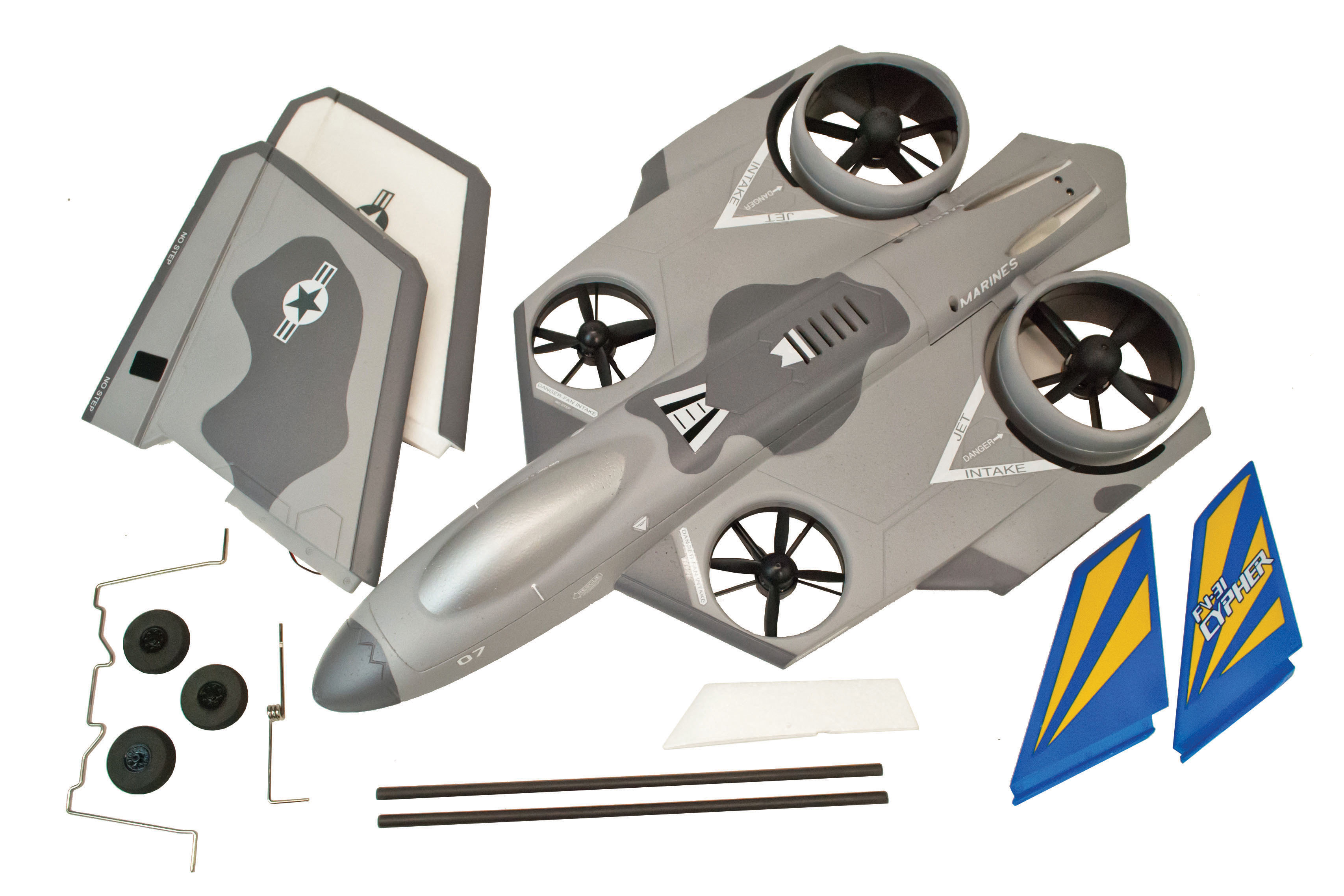
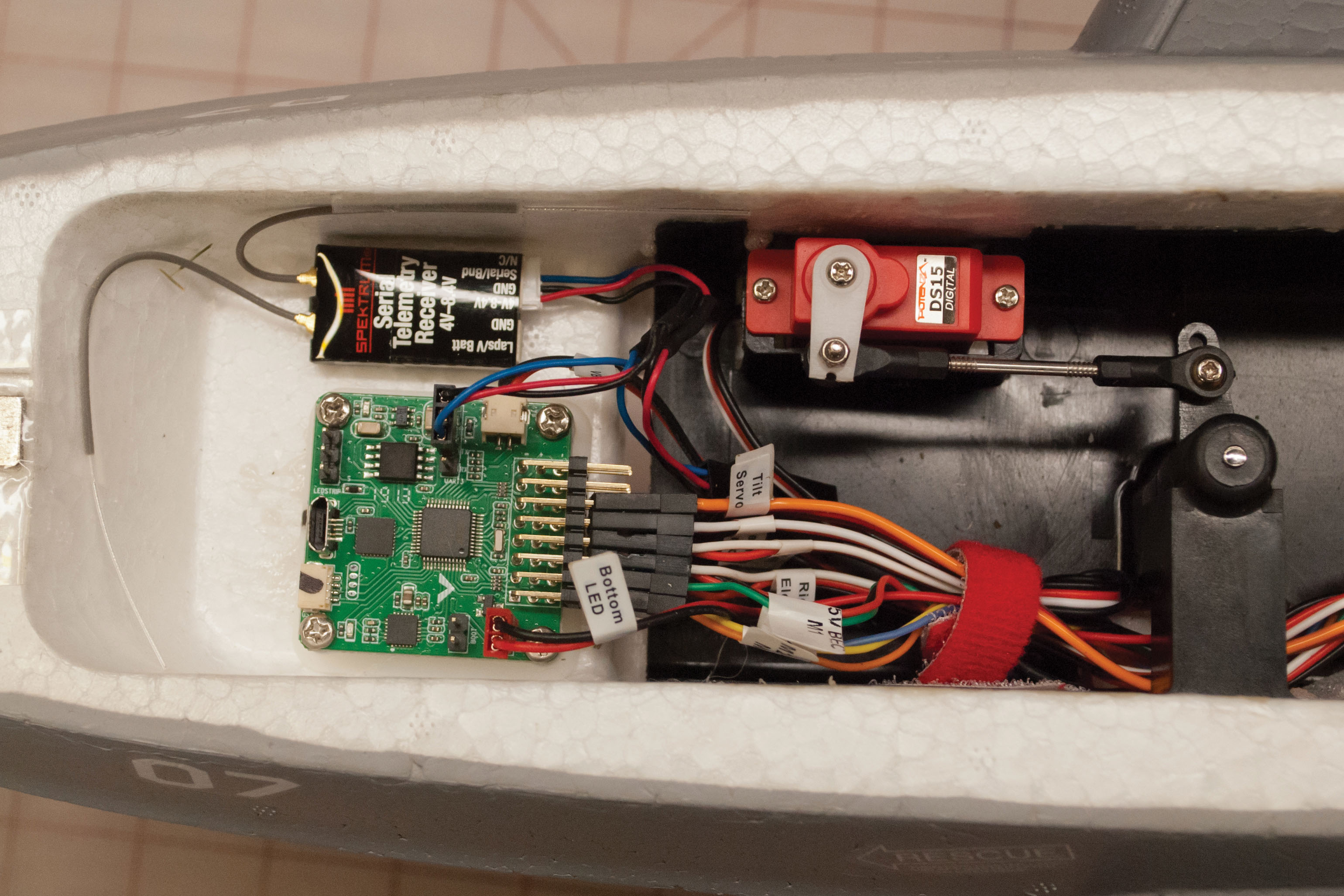
All of the brushless EDF units are factory installed and come with dedicated 40-amp ESCs. Three Potenza DS-15 digital servos are in place to handle the elevon control surfaces and nose wheel steering. A standard-size S0090 servo with metal gears actuates the beefy mechanism for tilting the rear fan units.
A printed assembly manual is included, but many of the photos are too dark to be helpful. I found the electronic version of the manual much easier to see clearly. It is available on Flex Innovations’ website. The website also has a Wiki page with loads of tips and hints for setting up the Cypher. It’s worth looking at before you begin assembly.
Building the FV-31
There are two distinct aspects of preparing the Cypher for flight: assembling the airframe and configuring the electronics. The manual begins with the electronic side of things. This is somewhat more involved than configuring a typical fixed-wing model because the FV-31 uses an onboard flight controller. The flight controller is basically a small circuit board with gyros that stabilize the aircraft in all phases of flight.
Some radio setups, or enabling telemetry features, may require you to reprogram the flight controller. This is accomplished with free interface software called Betaflight. The flight controller can be physically connected to your computer with a USB cable or to your cellphone or tablet with the included Bluetooth adapter.
Those who do not have experience configuring a multirotor should not feel intimidated. The process is relatively straightforward for anyone with average computer literacy; however, if you still struggle with email and Facebook, the Cypher may not be the best model for you.
My Spektrum receiver fits nicely next to the flight controller. All of the factory-installed radio wiring is clean and neatly bundled. This makes for a very tidy and attractive radio bay. On the transmitter side, I used my Spektrum iX12 and programmed it according to the guide in the FV-31’s manual.
Assembling the FV-31 begins with setting the rear fan units to the correct tilt angles. This is done by adjusting the length of the relevant pushrod and fine-tuning the servo endpoints on the transmitter. Plywood gauges are included to ensure that you set the angles correctly.
A foam shroud covers the tilt mechanism and servo. I noticed that the ball-link screw on the servo arm had gouged the inner surface of the shroud. To prevent future interference, I flipped the screw 180°.
The Cypher includes fixed tricycle landing gear. Plastic mounts for the main gear are embedded in the airplane’s belly. The nose gear is attached to the built-in steering mechanism with setscrews. I thought that the included wheels did not spin very well on the 3 mm diameter axles. They worked much better after enlarging the holes with a 1/8-inch (3.2 mm) drill bit in a pin vise.
I fly the FV-31 with a Potenza 3S 3,500 mAh 75C LiPo battery. It is fastened to a tray in the radio bay with hook-and-loop tape. Two straps around the battery ensure that it doesn’t shift in flight.
The Cypher’s power leads come equipped with EC3 connectors. I thought that the stock routing of these leads through the left side of the battery tray made it difficult to connect the battery. I was able to reroute the wires to the right side by temporarily unbolting the battery tray from its mounts. A small section of webbing had to be cut away from the battery tray to allow the connector to fit through, but the relocated wires are now much easier to manage.
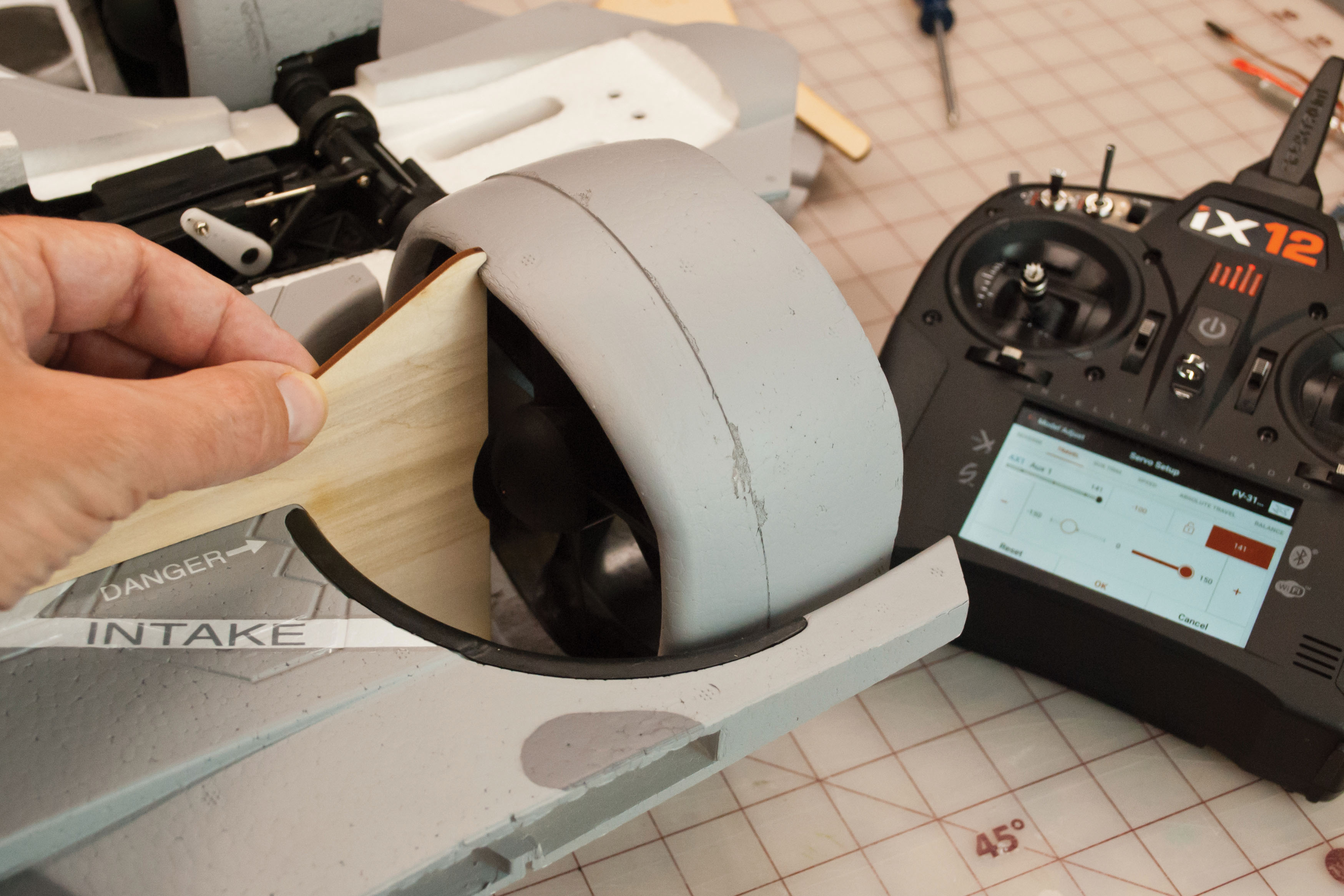
Profiles, Configurations, and Switches
It is important to recognize that the FV-31 is ultimately flown by the onboard flight controller. Your control inputs go to this circuit board, which analyzes the model’s current state, and translates your commands into control surface movements and/or throttle adjustments of each fan. There is no way to bypass or disable the flight controller. You might have the stick-and-rudder sensibilities of Bob Hoover, but those flying skills will be useless unless you also understand how to manage the flight controller.
The manual does a good job of explaining things. Make sure you take the time to become familiar with the two flight profiles (Beginner and Advanced), how they work, and how to switch between them. There is no shame in using the beginner mode as you familiarize yourself with the Cypher’s unique flying abilities.
The flight controller also provides three flight configurations. These configurations reflect the three possible tilt positions of the rear fans and are selected via a three-position switch on the transmitter. In the Hover configuration, the rear fans provide only vertical thrust. They work with the front fans (which are fixed to always provide vertical thrust) to essentially make the Cypher a quadrotor. The wings and elevons are merely ornamental here. Pitch, roll, yaw, lift, and translational speed are all governed by the four fan units working in unison.
If you’ve never flown a quadrotor, I suggest investing some time with an RC flight simulator or an inexpensive mini quadcopter (the Blade Inductrix is a good choice) before flying the FV-31. Multirotors are not difficult to fly, but they typically require a little training to develop a feel for the controls.
Conventional configuration twists the rear fans to provide purely forward, horizontal thrust. In this state, the Cypher is controlled much like a common fixed-wing model. It will perform rolling takeoffs and landings. It flies through the sky using lift from the wings.
In the Magic configuration, the rear fans are tilted downward at 45° to provide equal amounts of lift and forward thrust. This gives the FV-31 flying abilities that are not quite like a multirotor or a fixed-wing airplane. It is something in between—and very cool.
Flying the FV-31
In my initial hops with the Cypher, I used the Hover configuration. I found it easy to take off and land vertically in both Beginner and Advanced modes. I even spent some time tooling around the field at walking speed. Those of you with some stick time on multirotors will not have any trouble, but again, I do not suggest the Cypher for your first multirotor experience.
The next step for me was to get a feel for the Cypher in the Conventional configuration. It requires a long takeoff roll on my club’s grass runway, but it performs well.
Loops and rolls (Advanced mode only) are easy and fun. It flies with the ease of a four-channel sport flyer. My only disappointment is that the top speed is not as fast as I had hoped.
Next up was the Magic configuration. I expected a short ground roll, but the Cypher took to the air right away. The model naturally assumes a moderate forward speed. I found that I could keep the FV-31 hovering in place with back pressure on the stick. It will even fly backward!
Experimenting with forward flight revealed why this is called the Magic configuration. The FV-31 is capable of many maneuvers that are typically associated with a fixed-wing airplane. It just does them at unbelievably slow speeds. I particularly like doing back-flip-style loops.
The best way to experience the full breadth of the Cypher’s flight envelope is to transition between flight configurations on the fly. It takes a couple of seconds for the tilt mechanism to sweep from one setting to the next. This helps make configuration changeovers seamless. Going from any configuration to another can be a hands-off affair. Just make sure that you have adequate throttle input, flip the switch, and let the flight controller keep the FV-31 flying while the fans tilt.
Onlookers will be amazed when you perform a vertical takeoff in the Hover configuration. Then flip the switch for a full-throttle inverted pass in Conventional configuration. Be sure to include a tortoise-speed touch-and-go in Magic configuration. There are infinite possibilities!
With most of the models that I review, I feel as though I have a good grasp of their flying abilities within the first few flights. This is not so with the FV-31. There are so many options that I still feel as though I’m scratching the surface. I’ll be getting to know this airplane for a long time.
Deciphering the Cypher
The FV-31’s versatility does not come without a cost. Using a 3,500 mAh LiPo battery, my flights typically last somewhere between 3 and 4 minutes. I might be able to achieve more duration and I am cautiously extending my flight times in baby steps.
Another thing to consider is that the Cypher is an inherently complex model. This airplane has more bits and pieces to manage than most. For instance, trimming the airplane for level forward flight involves more than just the center of gravity and control surfaces. The rear fan angles and flight controller calibration must also be considered.
The FV-31 rewards those who are willing to manage its mechanical and electronic gadgetry. This model looks and performs like nothing I’ve ever flown. Whether you consider it an airplane with multirotor roots, a quadcopter with wings, or something else entirely, the distinction seems unimportant. The Cypher is a model for those of us who like to explore the fringes of RC flight.
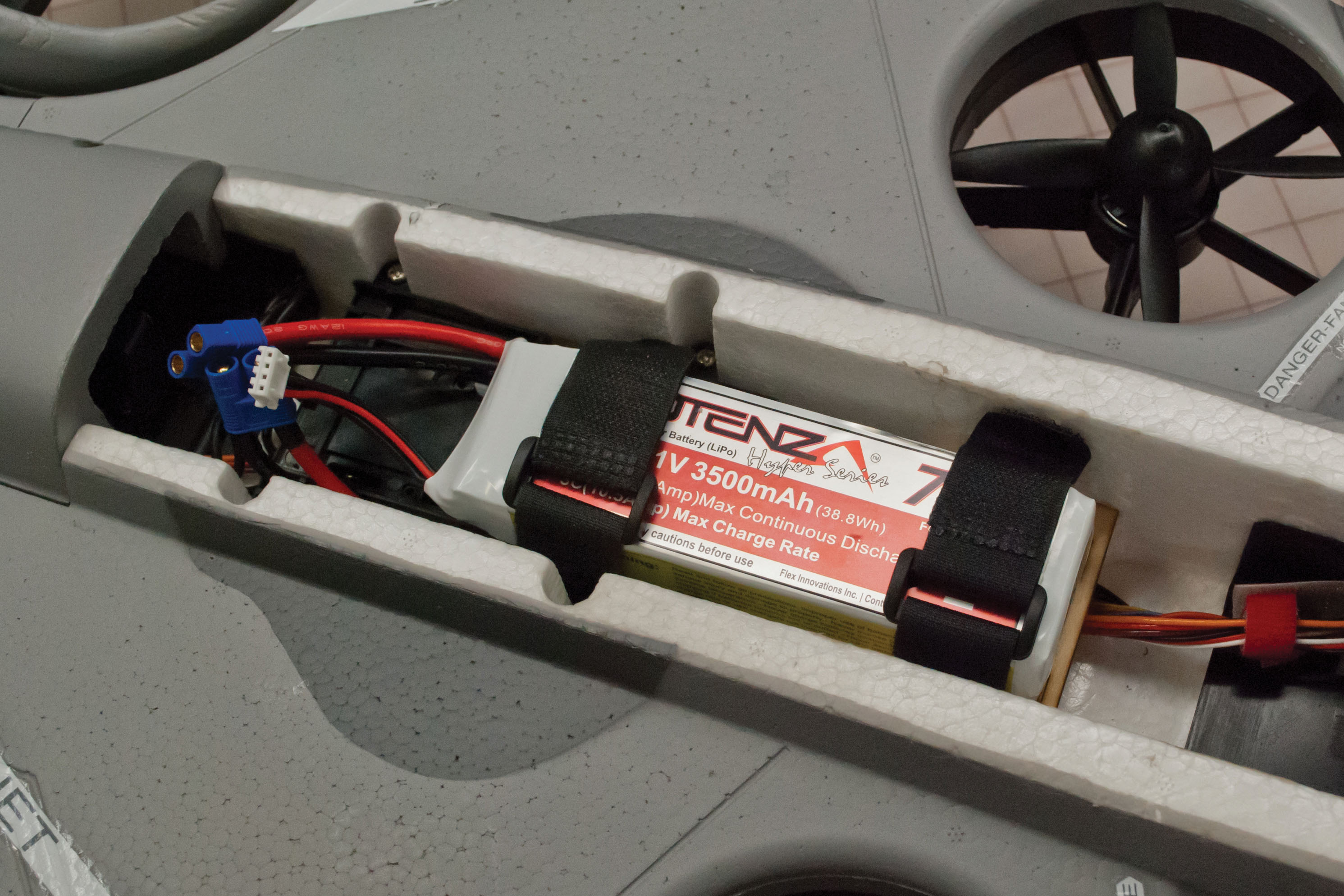
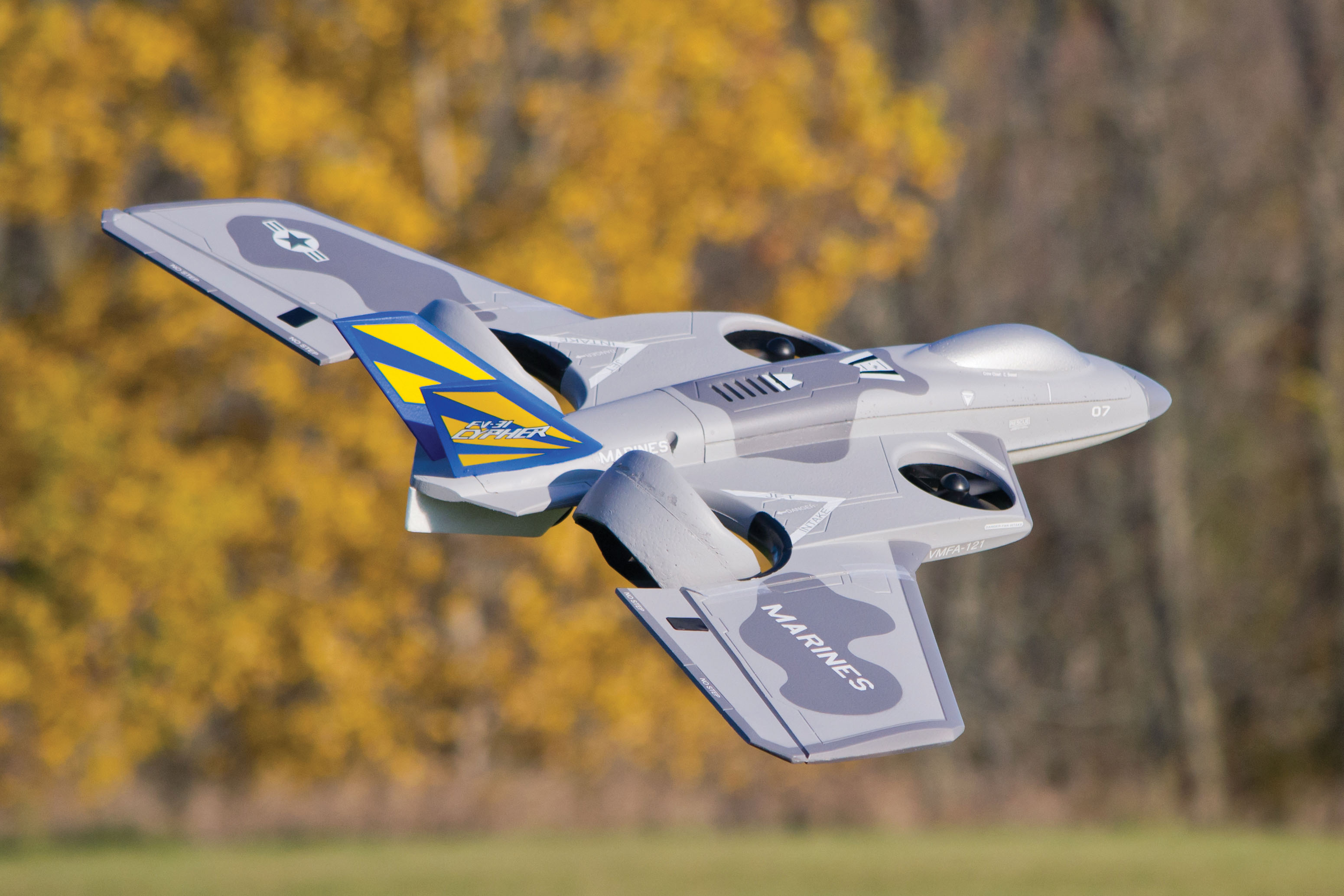
SOURCES:
Spektrum
(800) 338-4639
Betaflight










Add new comment